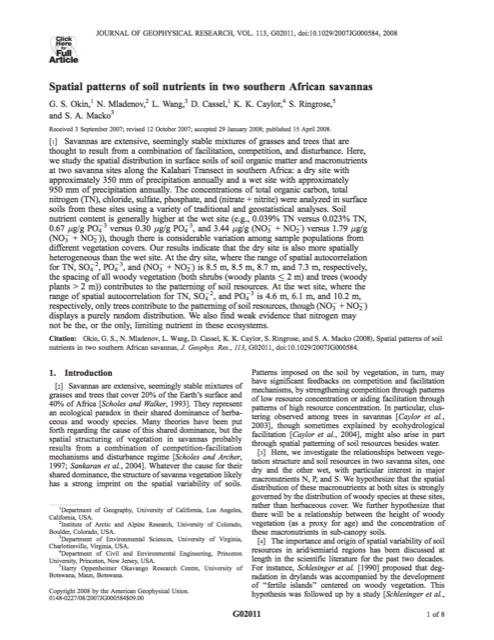Spatial patterns of soil nutrients in two contrasting southern African savannas

Okin, G.S., N. Mladenov, D. Cassel, G.S. Okin, K.K. Caylor, and S. Ringrose (2008) “Spatial patterns of soil nutrients in two contrasting southern African savannas,” JGR-Biogeosciences, Vol 113, G02011, doi:10.1029/2007JG000584..
Savannas are extensive, seemingly stable mixtures of grasses and trees that are thought to result from a combination of facilitation, competition, and disturbance. Here, we study the spatial distribution in surface soils of soil organic matter and macronutrients at two savanna sites along the Kalahari Transect in southern Africa: a dry site with approximately 350 mm of precipitation annually and a wet site with approximately 950 mm of precipitation annually. The concentrations of total organic carbon, total nitrogen (TN), chloride, sulfate, phosphate, and (nitrate + nitrite) were analyzed in surface soils from these sites using a variety of traditional and geostatistical analyses. Soil nutrient content is generally higher at the wet site (e. g., 0.039% TN versus 0.023% TN, 0.67 mu mg/g PO4-3 versus 0.30 mu g/g PO4-3, and 3.44 mu g/g (NO3-+ NO2-) versus 1.79 mu g/g (NO3- + NO2-)), though there is considerable variation among sample populations from different vegetation covers.
Our results indicate that the dry site is also more spatially heterogeneous than the wet site. At the dry site, where the range of spatial autocorrelation for TN, SO4-2, PO4-3, and (NO3- + NO2-) is 8.5 m, 8.5 m, 8.7 m, and 7.3 m, respectively, the spacing of all woody vegetation (both shrubs (woody plants <= 2 m) and trees (woody plants > 2 m)) contributes to the patterning of soil resources. At the wet site, where the range of spatial autocorrelation for TN, SO4-2, and PO4-3 is 4.6 m, 6.1 m, and 10.2 m, respectively, only trees contribute to the patterning of soil resources, though (NO3- + NO2-) displays a purely random distribution. We also find weak evidence that nitrogen may not be the, or the only, limiting nutrient in these ecosystems.
